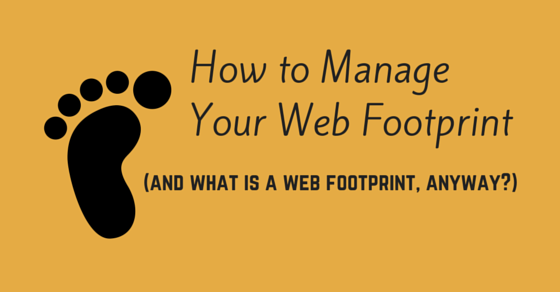What Is A Web Footprint?
How and Why You Need to Manage Your Web Footprint
 Nope, not Bigfoot meets Spiderman in a dark alley.
Nope, not Bigfoot meets Spiderman in a dark alley.
Let’s first rewind 40 years. Wait, that only puts us at at 1973.
I’m so old.
So let’s rewind 50 years, to make sure it feels (to me) like that was a long time ago.
In the 1960s, all you needed to become established as a business person was a business card. Run down to your local printing shop (Kinko’s wasn’t around until 1970) and get a one-sided, rectangular white business card with your phone number and physical address printed in black. Boom! You’re a business, now eligible to show up at a trade show or the State Fair to hawk your wares.
Then came marketing materials. Color brochures. Two sided, shiny foldouts ordinarily used to sell American-dream style homes in new developments. It stagnated there during the 1980s (apart from the Max Hedroom Coke ads, which I loved so much), but then we hit the 90s and email entered the picture. Suddenly, you were nobody without an email address, but that was easily remedied – Eudora and Yahoo were all the rage. Then we hit the millennium, and you needed a website too. Without a website, you were “of the stone age” and could not compete. You were anything but hip. By 2002, any company worth their salt had a website and through the first decade of the new millennium, website design exploded to include moving parts, movies and interactive graphics.
2010 brought the wave of social media and content marketing to the entrepreneur. Talk about leveling the playing field – suddenly anyone with a high speed connection could reach the masses on a personal level. That meant, however, that the bar had been raised again. Now, to be a legitimate business, you need not only business cards and a website, you need a blog and a social media presence. Enter the web footprint (also known, when referring to a single person rather than a brand, as a digital footprint.)
A web footprint is a modern marketing term for your brand, presence and influence on the Internet. It includes not only information, blogs and articles that you publish, but also includes anything your partners, clients, customers or competitors put out there as well (including criticism, constructive or not!) It is the ultimate culmination of your brand in the world today.
Your web footprint includes the following:
- Your tweets, tweets about you, tweets that mention or hashtag you
- Your Facebook posts and any Facebook posts that tag you
- Your LinkedIn updates and any statuses or comments you leave in LinkedIn groups
- Your comments on any and every social media site including commenting on blogs
- Your website and (hopefully consistent and well written) blog posts
- All of your guest blogs (you are guest blogging, right? If you’re not, here’s why you should.)
- Media attention and any reference to you in any publication
- Your Instagram, Pinterest, Tumblr, Google+ presence and activity
Yes, those are a lot of ingredients to manage, especially for a small business without a marketing department. Think of it as a complicated Julia Child recipe, which simply needs to scrutinized and broken into more manageable steps. Which you can absolutely do.
How can you manage your web footprint successfully, as a small business?
1) Make sure that you are managing your online reputation. Set up a Google Alert for any time your brand or company name is mentioned. That way, when a comment or reference appears, you’ll be the first to know, not the last to know.
2) Pay attention to those pesky emails from social media networks. When you are mentioned on Twitter, tagged on Facebook or a comment you made/link you posted on LinkedIn sparks conversation, you will receive an email notification. Don’t blow past it. Use the opportunity to do two things – keep the conversation going, and THANK the person who mentioned you!
3) Generate well written, informative content (blogs) on a consistent basis. It’s the quickest, cheapest, simplest way to establish yourself as an expert in your field.
Cultivating and managing your web footprint is crucial to success in this digital age. The bright side for entrepreneurs and small businesses is that the biggies (large, well known brands with heavy hitting resources and budgets) are no longer the only ones who have a voice. Use yours and manage it well!
 Submitted by Hilary
Submitted by Hilary
